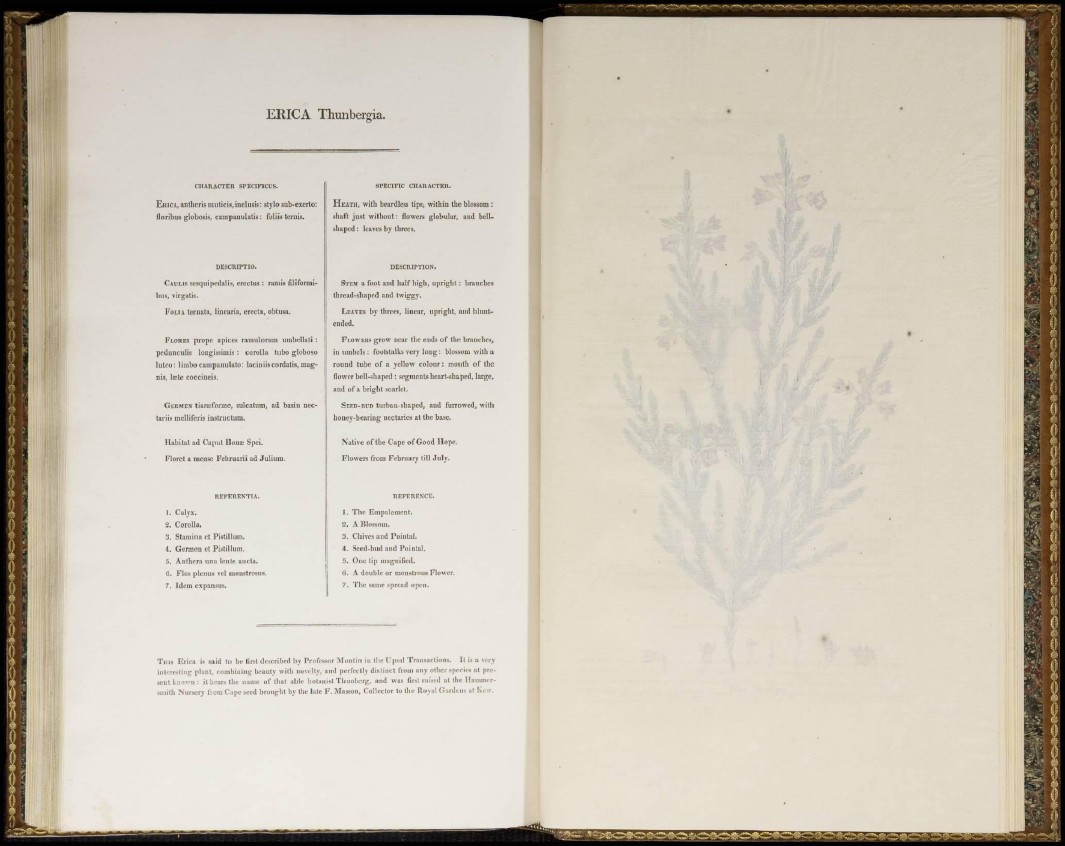
ERICA Thunbergia.
CHARACTER SPECIFICUS.
EitiCAj anthcris muticis, inclusis : stylo sub-exerto:
floribus globosis, campauulatis : foliis ternis.
DESCRIPTION
CAULIS sesquipedalis, erectus : ramis filiformibus,
virgatis.
FOLIA teruata, linearía, erecta, obtusa.
FLORES prope apices ramulorum umbellati :
pedunculís longissimis : corolla tubo globoso
lúteo: limbo campanulato: laciniiscordatis, magnis,
la;te coccineis.
GERMEN tiaroeformc, sulcatum, ad basin nectariis
mellifcris instructura.
Habitat ad Caput Bona; Spei.
Floret a mensc Februarii ad Julium.
REFERENTtA.
1. Calyx.
2. Corolla.
3 . Stamina et Pistillum.
4. Germen ct Pistillum.
5. Antbera una lentc aucta.
6. Flos plenus vel monstrosus.
7. Idem cxpansus.
SPECIFIC CHARACTER.
HEATH, with beardless tips, within the blossom :
shaft just without: flowers globular, and bellshaped:
leaves by threes.
DESCRIPTION.
STEM a foot and half high, upright: branches
thread-shaped and twiggy.
LEAVES by threes, linear, upright, and bluntended.
FLOWERS grow near the ends of the branches,
in umbels: footstalks very long: blossom with a
round tube of a yellow colour: mouth of the
flower bell-shaped: segments heart-shaped, large,
and of a bright scarlet.
SEED-EL-D turban-shaped, and furrowed, with
honey-bearing nectaries at the base.
Native of the Cape of Good Hope,
Flowers from February till July.
REFERENCE.
1. The Empalement.
2. A Blossom.
3 . Chives and Pointai.
4. Sccd-bud and Pointai.
5. One tip magnified.
6. A double or monstrous Fl
7. The same spread open.
THIS Erica is said to be first described by Professor Montin in the Upsal Transactions. It is a very
interesting plant, combining beauty with novelty, and perfectly distinct from any other species at present
known: it bears the name of that able botanist Thunhcrg, and was first raised at the Hammersmith
Nursery from Cape seed brought by the late F. Masson, Collector to the Royal Gardens at Kew,